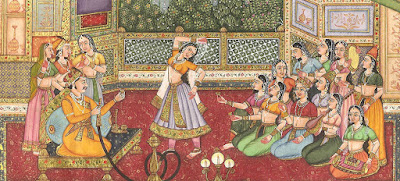Turmeric
Turmeric has been used for centuries in India
The main active ingredient of the spice, curcumin, is being used in new clinical trials for the prevention of Alzheimer's and the treatment of psoriasis. It is also on a trial for use in colon cancer.
But turmeric is not the only curry ingredient with health-boosting compounds. New research shows there are ten key ingredients found in popular curries such as Madras
FENUGREEK
The leaves and ground spice from the seed are used in many sauces, including vindaloo and the hot curries of Sri Lanka
One study found that fenugreek seeds may be effective against breast cancer. Researchers say it may stop or slow the growth of tumours.
A study at Tokyo University shows animals given the herb were able to exercise much longer, while a report from Purdue University in America
CORIANDER
The world's most popular herb, its leaves have a strong earthy taste, while the seeds have an aromatic, fruity flavour.
Research at Andhra University , India , shows it has more antioxidants than vitamin C, while a study at the University of Ulster
TURMERIC
A member of the ginger family, its roots are ground into the deep yellow spice used to give most curries their distinctive colour. Its key active ingredient is curcumin, and it is used in large amounts in almost all curries, mainly as a colouring agent.
It is currently in clinical trials for the treatment of pancreatic cancer, Alzheimer's and psoriasis.
In a study of 1,000 people, researchers from the National University of Singapore found that curcumin may protect brain cells from age-related changes. According to a report by researchers from Texas University
NUTMEG
The fruit of the nutmeg tree, it is strongly aromatic and used in a range of curries, but mostly found in yellow curry pastes.
Nutmeg boosts male libido, according to research at Aligarh University in India
CINNAMON
Based on the inner bark of an evergreen tree, the spice has a fragrant smell and a sweet, aromatic taste, and is found in almost all curries.
Research shows it can significantly lower blood-sugar levels in patients with diabetes. In a study at the U.S. Human Nutrition Research Centre, men and women with the more common type 2 diabetes were given cinnamon powder daily. Results show that blood-sugar levels dropped by up to 20 per cent compared to a control group.
Just how it works is not clear, but one theory is that a polyphenol in the spice called MHCP works like insulin.
FENNEL
From the same family as parsley and carrot, fennel has a sweet, liquorice smell and is used in Madras
According to a study at Kerman University of Medicine, Iran, it is a powerful pain reliever. In a trial for period paid, a group of young women given fennel for two months had a significant reduction in symptoms.
The herb has also been used to ease indigestion and symptoms of bronchitis.
CHILLI
Chilli pepper is the fruit of capsicum plant, part of the nightshade family, and a key ingredient in hot curries such as vindaloo.
They can prevent or heal stomach ulcers, according to researchers, who say there has been a misconception that eating a lot of chillies is bad for the stomach and that curries and other hot food cause heartburn, indigestion and ulcers. They found that chillies block acid production and improve blood flow in stomach tissue, which helps in both the prevention and healing of ulcers.
Other research shows gastric ulcers are three times less common in countries where large amounts of chillies are eaten, and that chillies burn up more calories and fat than other spices.
GINGER
The spice comes from the underground stems of the ginger plant, and is a staple ingredient of most curry powders.
A study at Kyoto Pharmaceutical University in Japan shows that it lowers the risk of stomach ulcers, while University of Miami
'Standardised ginger extract had a statistically significant effect on reducing symptoms,' scientists reported.
CARDAMOM
The dried fruit of a member of the ginger family, it has a pungent, aromatic flavour. Research at the Central Food Technological Research Institute in India
They tested blood samples and found that the greater the amount of spice used, the fewer clotting problems there were.
The spice is also used in traditional medicine for a variety of conditions, including sore throats, indigestion and stomach problems.
CURRY LEAVES
Fresh curry leaves, from the Murraya koenigii plant, are highly aromatic. A key ingredient of Madras
Eating curry leaves lowers cholesterol and weight, and may be useful for people with diabetes, according to research at the University of Chicago


Comments
I love your site.